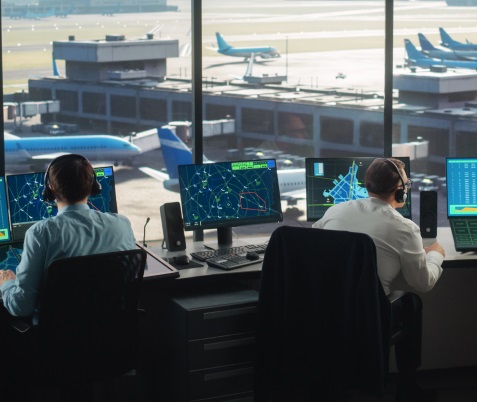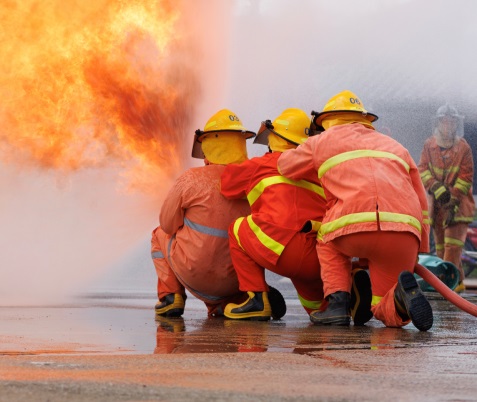Aviation Training & Certification
The world of aviation is exciting and demanding. Workers in this field keep airplanes flying on time, to the correct destinations, and with minimal mishaps.
Whether you are seeking a career as an aviation mechanic, technician, air traffic controller, airport operations worker, pilot, or in a similar field, you’ll need to receive proper training before you can start your first job. Most of these positions will fall under the regulatory arm of the FAA, which certifies training programs and graduates alike. Students in any of the licensed careers will need to complete the required number of instructional hours and pass a comprehensive examination. Some aviation careers may also require continued education to maintain one’s license.
What Programs are Available for Aviation?
Aviation mechanics have a few options available for their job training. The two primary paths to becoming an aviation mechanic are through academic training and on-the-job training. The academic route will take up to 1,900 hours which can be broken out over three sections. To qualify for one of these programs, students must first achieve either a high school diploma or pass their General Educational Development Exam (GED).
According to the FAA, aviation mechanics need to spend 400 hours studying the general concepts and terms related to aviation mechanics. The next 750 hours are then spent studying the airframe and another 750 hours focusing on the powerplant. Once all 1,900 hours are complete, students must be able to take examinations that qualifies them for an airframe and powerplant certificate, often referred to as the A&P Certificate. Note that students can opt to become certified in one only one area, such as an airframe certificate but, with both, they have even more opportunities available.
Those who are interested in becoming pilots must complete a series of steps, becoming certified to fly smaller to larger planes over time. They will earn their Private Pilot Certificate, which can be earned in around three months or could take a couple of years depending on how often you can get in flight hours. Then they earn an instrument rating; this means that you have experience and can fly solely using instruments rather than visuals, which allows you to fly in the clouds, through the night, and through storms. Next is the commercial pilot certificate and multi-engine rating. Pilots can also earn a flight instructor certificate, which allows them to teach others to fly. After this, the most important thing is to gain experience. Depending on weather, availability, and finances, all of this could take as little as 9 months, or it could take years.
Becoming an air traffic controller may require an associate degree or bachelor’s degree from an approved Air Traffic Collegiate Training Initiative program. With this, you’ll be ready to get right into the field. However, you could also gain on the job training and move into the field more slowly, but you’ll still need to have a bachelor’s degree if you follow this route.
What Will You Learn in an Aviation Program?
Aviation programs are very specific, depending on what career you are looking to enter. Aviation mechanics focus on the airframe and powerplant of an aircraft so they can effectively maintain them to FAA standards. The academic training encompasses both in-class instruction and practical applications of that knowledge. Since aircraft have so many moving and stationary parts, the course list is long and comprehensive.
For pilots, the focus is time spent in the air. You need to learn all the basics, of course, and there are differing skills required to handle a prop plane vs a multi-engine craft, but the focus is on having spent enough time using those skills in various instances so that you will be prepared to deal with the vagaries of a flight, whether that is a change in weather, damage to your craft, or other unforeseen circumstances. That is why flight hours and instrument rating are so important, especially if you are hoping to pilot large passenger flights.
While a technical degree or certificate will focus solely on the skills you need in your career, students might consider obtaining a full associate degree anyway. With this degree in hand, students will complete the core curriculum necessary for any future college degree. Even those who don’t have any plans to complete a full undergraduate degree should consider this option. Those core courses will help them become better professionals with an increased knowledge of English grammar and composition, mathematics, and general humanities courses that help create a well-rounded individual. An associate degree may also offer opportunities to take courses in management or accounting, which can help any professional improve their standing within an organization or start their own business.
Depending on the community college, students may be able to take some or all these core college courses in a classroom or online. The online option can help aviation mechanics or pilots free up time for their practical training or a part-time job. In fact, there may even be programs that offer their entire curriculum online.
Choosing an Aviation Program
Online vs. On-Campus
Since all aviation programs include both time in the classroom and in practical applications, there are programs that combine both online and hands-on instruction. Thus, the classroom work can be done at home or on one’s own time but then they must adhere to scheduled practicum times. The online option is very flexible and can be a terrific option for students who need to continue working while they strive to achieve their career goals.
While online classes can seem daunting and difficult, they can be a real boon to students. This is at least partially because their instructors are only email or instant messages away. In the online world, all students are on an even playing field and students can easily ask all questions. However, students are urged to contact their instructors and establish that connection. Students who engage with their instructors are likely to find the most success.
Find Your Online Aviation College
| Quick Facts: Aircraft and Avionics Equipment Mechanics and Technicians | |
|---|---|
| 2023 Median Pay ?The wage at which half of the workers in the occupation earned more than that amount and half earned less. Median wage data are from the BLS Occupational Employment and Wage Statistics survey. In May 2023, the median annual wage for all workers was $48,060. | $75,400 per year $36.25 per hour |
| Typical Entry-Level Education ?Typical level of education that most workers need to enter this occupation. | Postsecondary nondegree award |
| Work Experience in a Related Occupation ?Work experience that is commonly considered necessary by employers, or is a commonly accepted substitute for more formal types of training or education. | None |
| On-the-job Training ?Additional training needed (postemployment) to attain competency in the skills needed in this occupation. | None |
| Number of Jobs, 2023 ?The employment, or size, of this occupation in 2023, which is the base year of the 2023-33 employment projections. | 163,300 |
| Job Outlook, 2023-33 ?The projected percent change in employment from 2023 to 2033. The average growth rate for all occupations is 4 percent. | 5% (As fast as average) |
| Employment Change, 2023-33 ?The projected numeric change in employment from 2023 to 2033. | 8,900 |
Job Placement Assistance
Most reputable aviation-focused schools will provide job placement assistance for their graduates. No matter what they are teaching, it’s likely that there is a local demand for those skills. There are even aviation mechanic and flight training schools that operate nationwide. These may offer students the ability to seek employment in some other city or state.
However, it’s not a given that all programs will support their students in this way. It’s therefore very important to discuss this vital part of the process with an admissions counselor. Students should include a discussion on the possibility of internships or apprentice programs at this time. There may even be apprentice programs that offer some sort of tuition reimbursement or scholarship funds.
Students should also seek out professional associations, such as the Aircraft Mechanics Fraternal Association (AMFA) or the Air Transport Association (ATA), which can offer career development resources. Such associations offer professionals fresh opportunities, networking, and fellowship with like-minded professionals.
Additional Aviation Careers
To make a plane or helicopter take off for the wild blue yonder there needs to be a massive team behind each take-off, in-flight operations, and landing. There are many aviation career opportunities out there, beyond what we’ve talked about on this page. For each of these, there are training programs and degrees offered at colleges, universities, ad trade or technical programs. There is a wide range of possible careers for those who love aviation and air transportation.
Here is a small sample:
Air Traffic Controller:
This is a highly stressful position that requires nerves of steel, impeccable concentration, and a dedication to learning and growing in the field. To work in this position, you must be licensed by the FAA. To qualify, applicants must be under 30 years old, pass medical and security guidelines, and be US citizens. The FAA reports that the median salary for this position is over $127,000 and that entry-level pay increases as professionals complete training phases.
Airline Pilots:
To start a career as a professional airline pilot, you will need to become licensed by the Federal Aviation Administration. The minimum formal education for this field is a high school diploma. What’s important in this field is logging flight hours. With enough hours, the ability to land a job with an airline increases. Many airline pilots begin as military pilots, where they must first complete a bachelor’s degree and officer status.
Commercial Freight Pilot:
Many pilots prefer flying for shipping carriers such as FedEx or UPS where their passengers are all inert boxes. This position requires you to have extensive flight experience and likely a bachelor’s degree. Commercial freight pilots can fly all over the world and enjoy terrific salaries and benefits.
Aviation Safety Inspector:
Safety is a huge part of aviation. Airplanes are massive machines but since they operate in such adverse conditions, every piece must be inspected consistently. Aviation safety inspectors also work on things like safety policies, including checking on the competencies of pilots, mechanics, and the aviation facilities themselves.
Airway Transportation Systems Specialists:
This is an area of the FAA that includes five separate specialty areas:
- Environmental specialists who work on things such as airplane air conditioning and more.
- Radar specialists who work on navigation systems as well as weather radar.
- Navigational aids specialists who maintain and repair equipment are vital to air traffic navigation.
- Communications specialists who maintain and repair communications equipment
Financing and Scholarships
Unless you find an opportunity to learn aviation mechanics on the job or gain flight training through a military position, you will likely need to finance your education. Since there are few, if any, federal grants or loans available for tradespeople, aviation mechanics and pilots must seek out funding resources elsewhere. Luckily, there are many options available for those in technical trades.
Though the federal government does not provide much, if any, assistance to those seeking professional education, the FAA does provide a healthy resource on its website. There, you will find a lengthy list of scholarships. This financing option is superior to standard student loans because a scholarship doesn’t need to be repaid. Nevertheless, sometimes loans are unavoidable. If that seems likely, investigate whether you can work towards an associate degree instead, for which federal funding may be available.
Please discuss this with your admissions counselor prior to enrolling in courses.
The ASIST scholarship is a generous program that helps aspiring aviation mechanics afford their education and thrive in their profession. Students need to apply through a local chapter of Executive Women International. The ASIST scholarships range from $2000 to $10,000.
This is a merit-based scholarship program that includes students in any field. It is also open to both graduating high school seniors as well as non-traditional, adult learners. The first prize is a $1,000 payday that helps students cover their educational expenses.
This is an enormously popular scholarship program so prospective students should apply as early as possible. Tradespeople across a wide range of trades are welcome to apply, including truck drivers, motorcycle mechanics, plumbers, and aviation experts.
Though the federal government isn’t a lot of help for those seeking professional degrees, the FAA does offer a rather lengthy list of scholarship opportunities for aspiring aviation professionals. These resources include options from private companies such as Boeing, but also from private foundations that are dedicated to aviation.



